Comparative Analysis of Dining Consumption in Various Restaurants
VerifiedAdded on 2022/11/10
|9
|1859
|234
Report
AI Summary
This report provides a comprehensive analysis of dining consumption in restaurants, examining various research articles and their methodologies. The report explores the importance of understanding consumer behavior to satisfy customer demands and improve service models. It reviews articles that use qualitative, quantitative, and mixed methods, conducted in different restaurant settings like green and luxury restaurants. The analysis highlights similarities in the objectives of the studies, such as understanding consumer behavior and the services provided, while also pointing out differences in data collection, findings, limitations, and future research directions. The report discusses the impact of dining consumption models, service quality, and customer satisfaction. It concludes by emphasizing the significance of a deep understanding of consumer behavior for restaurants to meet customer needs effectively and suggesting avenues for future research, including comparative studies across different income groups and geographical locations.
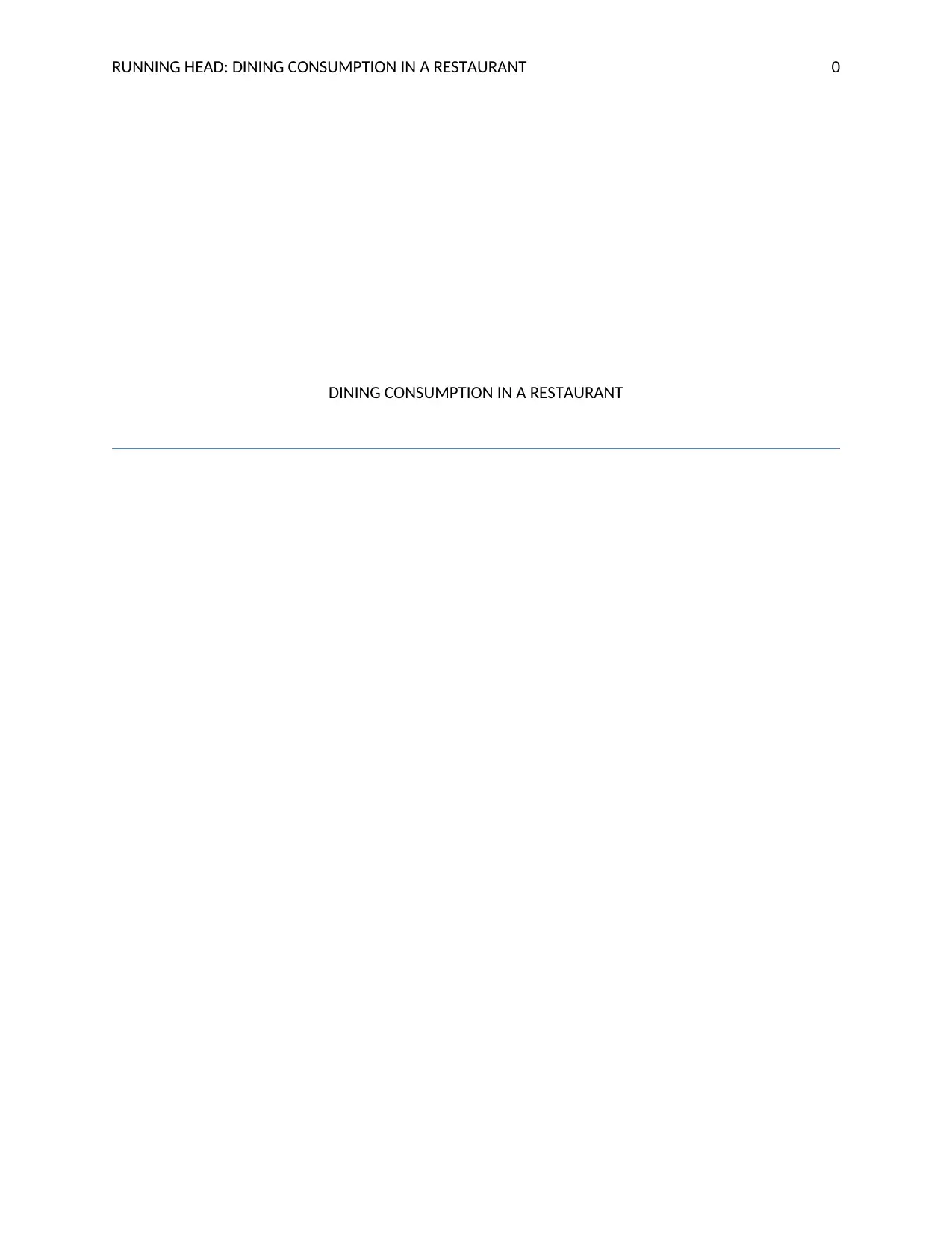
RUNNING HEAD: DINING CONSUMPTION IN A RESTAURANT 0
DINING CONSUMPTION IN A RESTAURANT
DINING CONSUMPTION IN A RESTAURANT
Paraphrase This Document
Need a fresh take? Get an instant paraphrase of this document with our AI Paraphraser
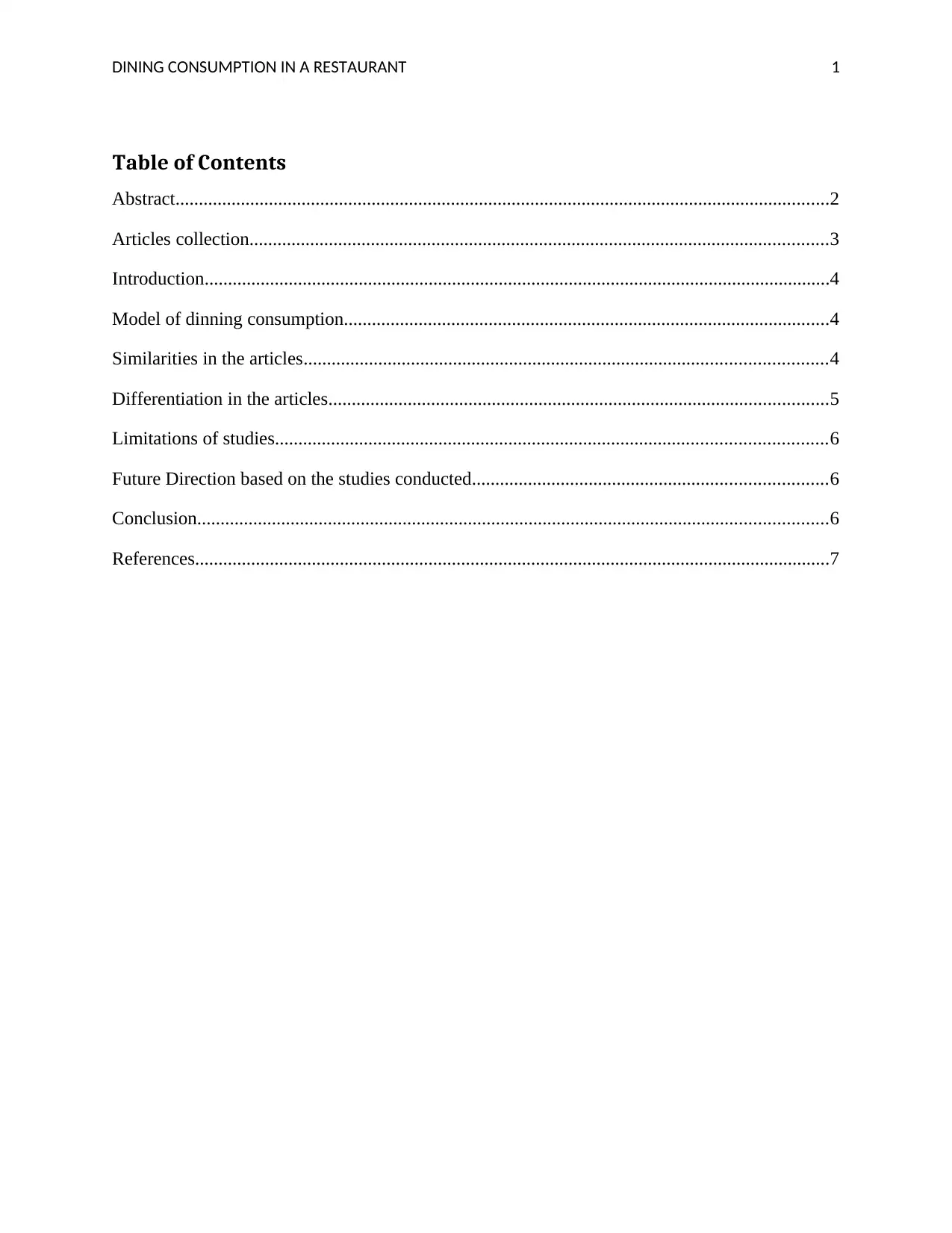
DINING CONSUMPTION IN A RESTAURANT 1
Table of Contents
Abstract............................................................................................................................................2
Articles collection............................................................................................................................3
Introduction......................................................................................................................................4
Model of dinning consumption........................................................................................................4
Similarities in the articles................................................................................................................4
Differentiation in the articles...........................................................................................................5
Limitations of studies......................................................................................................................6
Future Direction based on the studies conducted............................................................................6
Conclusion.......................................................................................................................................6
References........................................................................................................................................7
Table of Contents
Abstract............................................................................................................................................2
Articles collection............................................................................................................................3
Introduction......................................................................................................................................4
Model of dinning consumption........................................................................................................4
Similarities in the articles................................................................................................................4
Differentiation in the articles...........................................................................................................5
Limitations of studies......................................................................................................................6
Future Direction based on the studies conducted............................................................................6
Conclusion.......................................................................................................................................6
References........................................................................................................................................7
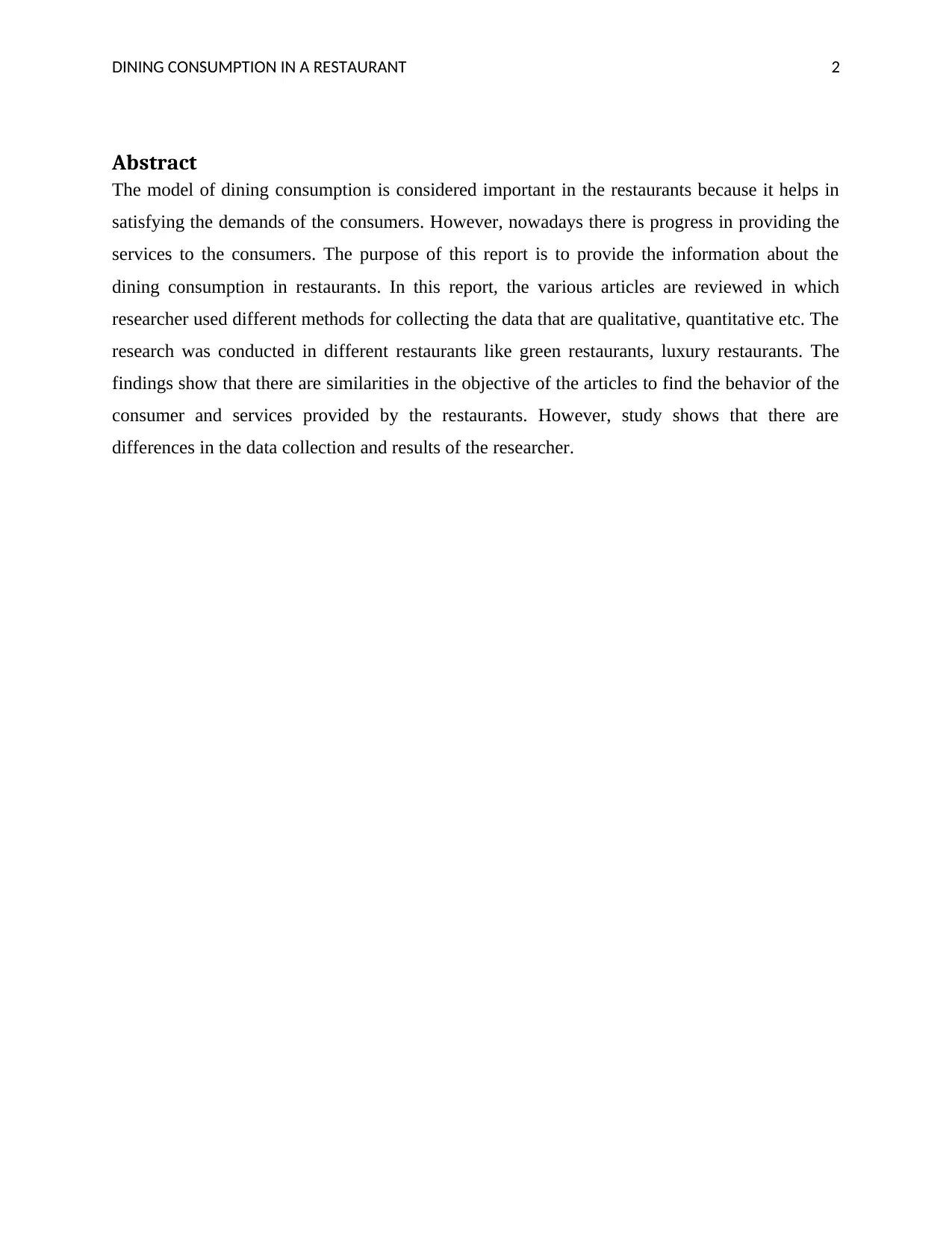
DINING CONSUMPTION IN A RESTAURANT 2
Abstract
The model of dining consumption is considered important in the restaurants because it helps in
satisfying the demands of the consumers. However, nowadays there is progress in providing the
services to the consumers. The purpose of this report is to provide the information about the
dining consumption in restaurants. In this report, the various articles are reviewed in which
researcher used different methods for collecting the data that are qualitative, quantitative etc. The
research was conducted in different restaurants like green restaurants, luxury restaurants. The
findings show that there are similarities in the objective of the articles to find the behavior of the
consumer and services provided by the restaurants. However, study shows that there are
differences in the data collection and results of the researcher.
Abstract
The model of dining consumption is considered important in the restaurants because it helps in
satisfying the demands of the consumers. However, nowadays there is progress in providing the
services to the consumers. The purpose of this report is to provide the information about the
dining consumption in restaurants. In this report, the various articles are reviewed in which
researcher used different methods for collecting the data that are qualitative, quantitative etc. The
research was conducted in different restaurants like green restaurants, luxury restaurants. The
findings show that there are similarities in the objective of the articles to find the behavior of the
consumer and services provided by the restaurants. However, study shows that there are
differences in the data collection and results of the researcher.
⊘ This is a preview!⊘
Do you want full access?
Subscribe today to unlock all pages.

Trusted by 1+ million students worldwide
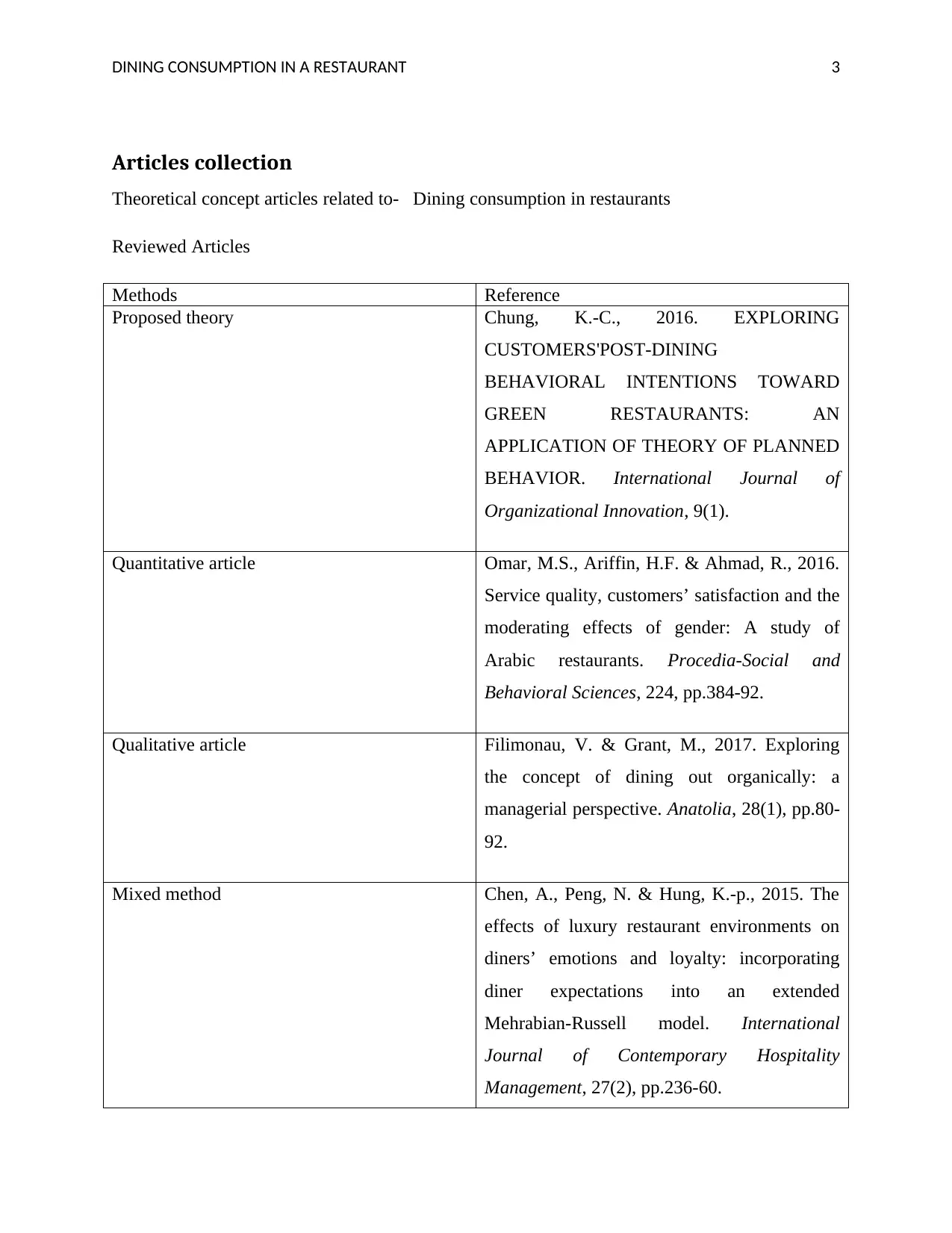
DINING CONSUMPTION IN A RESTAURANT 3
Articles collection
Theoretical concept articles related to- Dining consumption in restaurants
Reviewed Articles
Methods Reference
Proposed theory Chung, K.-C., 2016. EXPLORING
CUSTOMERS'POST-DINING
BEHAVIORAL INTENTIONS TOWARD
GREEN RESTAURANTS: AN
APPLICATION OF THEORY OF PLANNED
BEHAVIOR. International Journal of
Organizational Innovation, 9(1).
Quantitative article Omar, M.S., Ariffin, H.F. & Ahmad, R., 2016.
Service quality, customers’ satisfaction and the
moderating effects of gender: A study of
Arabic restaurants. Procedia-Social and
Behavioral Sciences, 224, pp.384-92.
Qualitative article Filimonau, V. & Grant, M., 2017. Exploring
the concept of dining out organically: a
managerial perspective. Anatolia, 28(1), pp.80-
92.
Mixed method Chen, A., Peng, N. & Hung, K.-p., 2015. The
effects of luxury restaurant environments on
diners’ emotions and loyalty: incorporating
diner expectations into an extended
Mehrabian-Russell model. International
Journal of Contemporary Hospitality
Management, 27(2), pp.236-60.
Articles collection
Theoretical concept articles related to- Dining consumption in restaurants
Reviewed Articles
Methods Reference
Proposed theory Chung, K.-C., 2016. EXPLORING
CUSTOMERS'POST-DINING
BEHAVIORAL INTENTIONS TOWARD
GREEN RESTAURANTS: AN
APPLICATION OF THEORY OF PLANNED
BEHAVIOR. International Journal of
Organizational Innovation, 9(1).
Quantitative article Omar, M.S., Ariffin, H.F. & Ahmad, R., 2016.
Service quality, customers’ satisfaction and the
moderating effects of gender: A study of
Arabic restaurants. Procedia-Social and
Behavioral Sciences, 224, pp.384-92.
Qualitative article Filimonau, V. & Grant, M., 2017. Exploring
the concept of dining out organically: a
managerial perspective. Anatolia, 28(1), pp.80-
92.
Mixed method Chen, A., Peng, N. & Hung, K.-p., 2015. The
effects of luxury restaurant environments on
diners’ emotions and loyalty: incorporating
diner expectations into an extended
Mehrabian-Russell model. International
Journal of Contemporary Hospitality
Management, 27(2), pp.236-60.
Paraphrase This Document
Need a fresh take? Get an instant paraphrase of this document with our AI Paraphraser
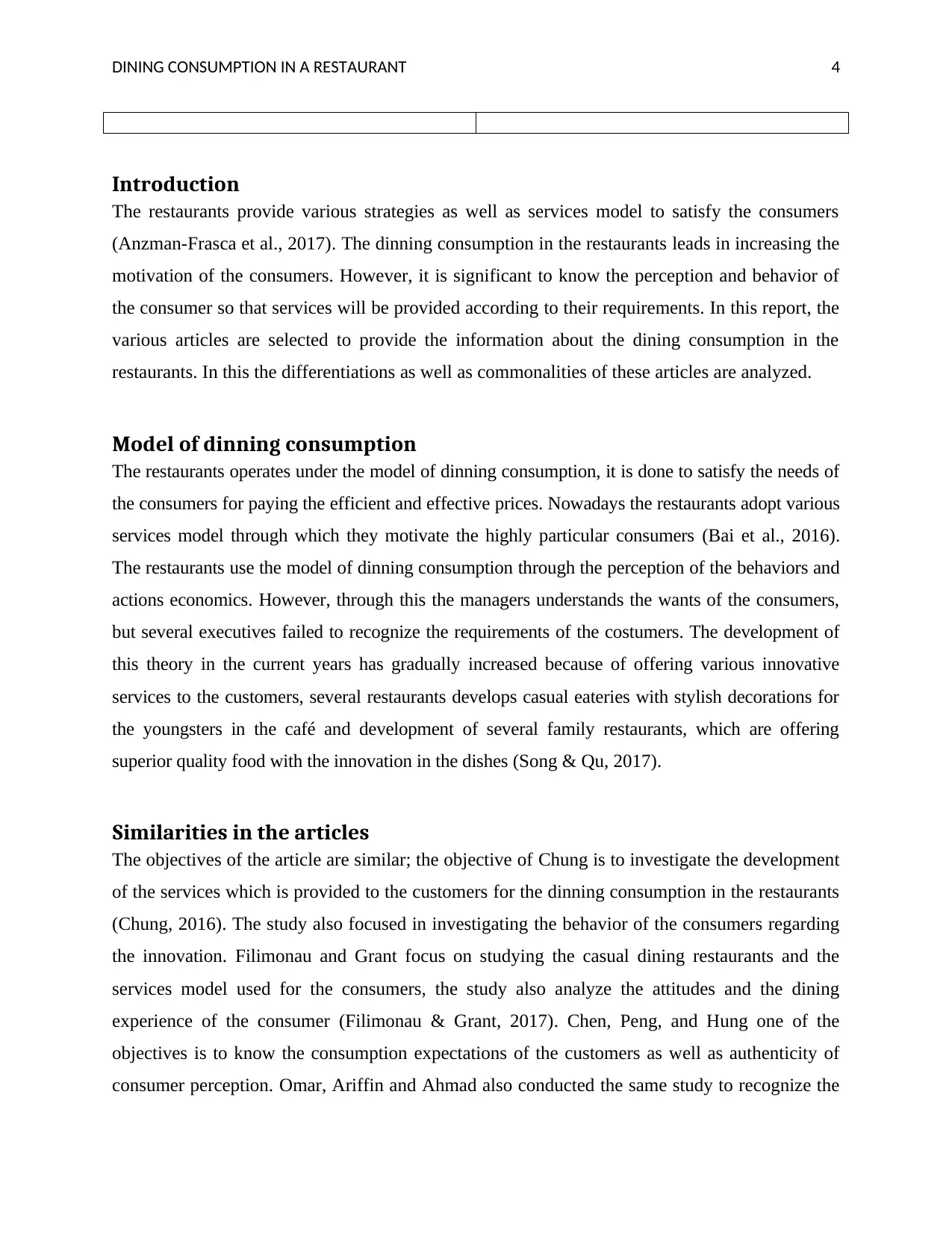
DINING CONSUMPTION IN A RESTAURANT 4
Introduction
The restaurants provide various strategies as well as services model to satisfy the consumers
(Anzman-Frasca et al., 2017). The dinning consumption in the restaurants leads in increasing the
motivation of the consumers. However, it is significant to know the perception and behavior of
the consumer so that services will be provided according to their requirements. In this report, the
various articles are selected to provide the information about the dining consumption in the
restaurants. In this the differentiations as well as commonalities of these articles are analyzed.
Model of dinning consumption
The restaurants operates under the model of dinning consumption, it is done to satisfy the needs of
the consumers for paying the efficient and effective prices. Nowadays the restaurants adopt various
services model through which they motivate the highly particular consumers (Bai et al., 2016).
The restaurants use the model of dinning consumption through the perception of the behaviors and
actions economics. However, through this the managers understands the wants of the consumers,
but several executives failed to recognize the requirements of the costumers. The development of
this theory in the current years has gradually increased because of offering various innovative
services to the customers, several restaurants develops casual eateries with stylish decorations for
the youngsters in the café and development of several family restaurants, which are offering
superior quality food with the innovation in the dishes (Song & Qu, 2017).
Similarities in the articles
The objectives of the article are similar; the objective of Chung is to investigate the development
of the services which is provided to the customers for the dinning consumption in the restaurants
(Chung, 2016). The study also focused in investigating the behavior of the consumers regarding
the innovation. Filimonau and Grant focus on studying the casual dining restaurants and the
services model used for the consumers, the study also analyze the attitudes and the dining
experience of the consumer (Filimonau & Grant, 2017). Chen, Peng, and Hung one of the
objectives is to know the consumption expectations of the customers as well as authenticity of
consumer perception. Omar, Ariffin and Ahmad also conducted the same study to recognize the
Introduction
The restaurants provide various strategies as well as services model to satisfy the consumers
(Anzman-Frasca et al., 2017). The dinning consumption in the restaurants leads in increasing the
motivation of the consumers. However, it is significant to know the perception and behavior of
the consumer so that services will be provided according to their requirements. In this report, the
various articles are selected to provide the information about the dining consumption in the
restaurants. In this the differentiations as well as commonalities of these articles are analyzed.
Model of dinning consumption
The restaurants operates under the model of dinning consumption, it is done to satisfy the needs of
the consumers for paying the efficient and effective prices. Nowadays the restaurants adopt various
services model through which they motivate the highly particular consumers (Bai et al., 2016).
The restaurants use the model of dinning consumption through the perception of the behaviors and
actions economics. However, through this the managers understands the wants of the consumers,
but several executives failed to recognize the requirements of the costumers. The development of
this theory in the current years has gradually increased because of offering various innovative
services to the customers, several restaurants develops casual eateries with stylish decorations for
the youngsters in the café and development of several family restaurants, which are offering
superior quality food with the innovation in the dishes (Song & Qu, 2017).
Similarities in the articles
The objectives of the article are similar; the objective of Chung is to investigate the development
of the services which is provided to the customers for the dinning consumption in the restaurants
(Chung, 2016). The study also focused in investigating the behavior of the consumers regarding
the innovation. Filimonau and Grant focus on studying the casual dining restaurants and the
services model used for the consumers, the study also analyze the attitudes and the dining
experience of the consumer (Filimonau & Grant, 2017). Chen, Peng, and Hung one of the
objectives is to know the consumption expectations of the customers as well as authenticity of
consumer perception. Omar, Ariffin and Ahmad also conducted the same study to recognize the
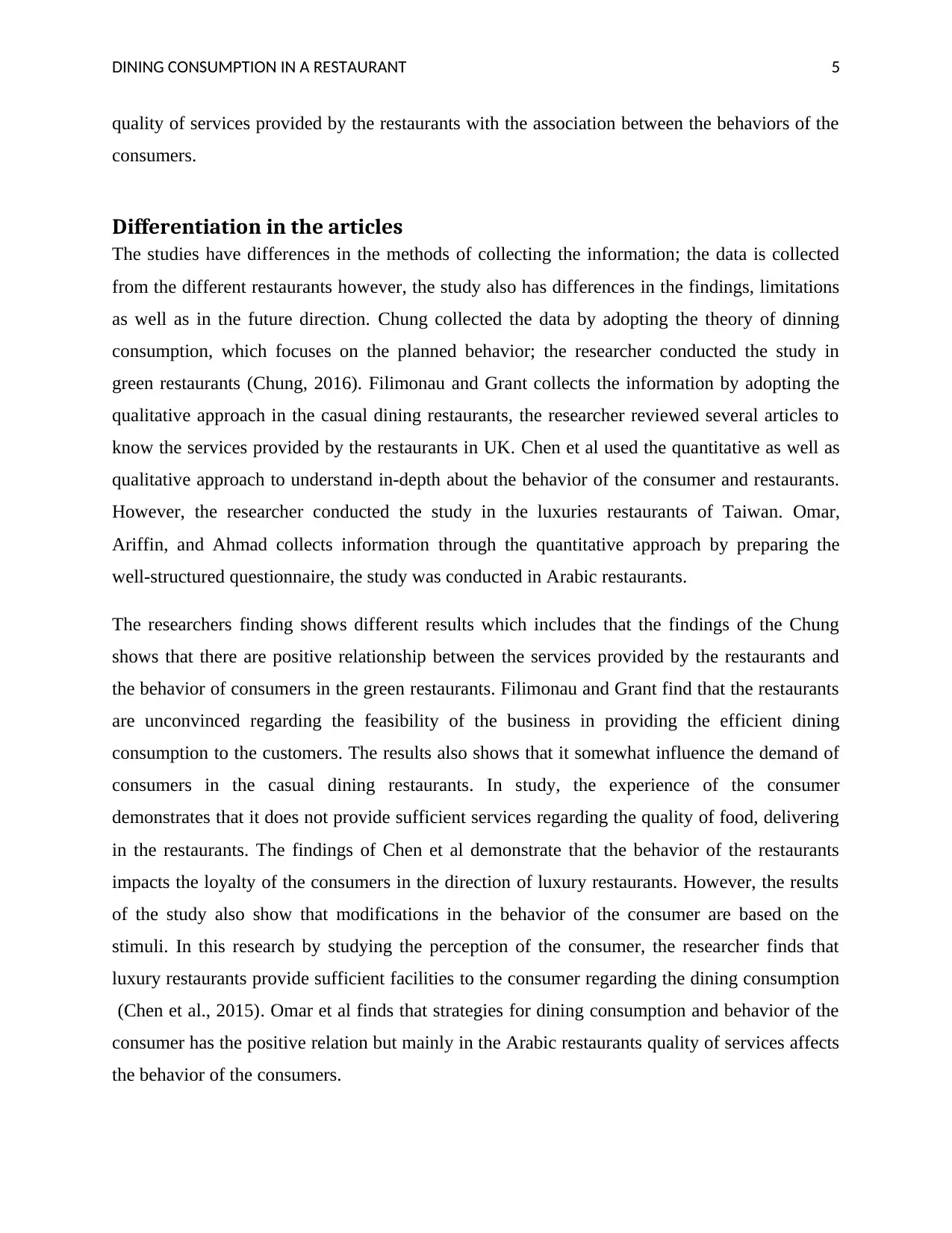
DINING CONSUMPTION IN A RESTAURANT 5
quality of services provided by the restaurants with the association between the behaviors of the
consumers.
Differentiation in the articles
The studies have differences in the methods of collecting the information; the data is collected
from the different restaurants however, the study also has differences in the findings, limitations
as well as in the future direction. Chung collected the data by adopting the theory of dinning
consumption, which focuses on the planned behavior; the researcher conducted the study in
green restaurants (Chung, 2016). Filimonau and Grant collects the information by adopting the
qualitative approach in the casual dining restaurants, the researcher reviewed several articles to
know the services provided by the restaurants in UK. Chen et al used the quantitative as well as
qualitative approach to understand in-depth about the behavior of the consumer and restaurants.
However, the researcher conducted the study in the luxuries restaurants of Taiwan. Omar,
Ariffin, and Ahmad collects information through the quantitative approach by preparing the
well-structured questionnaire, the study was conducted in Arabic restaurants.
The researchers finding shows different results which includes that the findings of the Chung
shows that there are positive relationship between the services provided by the restaurants and
the behavior of consumers in the green restaurants. Filimonau and Grant find that the restaurants
are unconvinced regarding the feasibility of the business in providing the efficient dining
consumption to the customers. The results also shows that it somewhat influence the demand of
consumers in the casual dining restaurants. In study, the experience of the consumer
demonstrates that it does not provide sufficient services regarding the quality of food, delivering
in the restaurants. The findings of Chen et al demonstrate that the behavior of the restaurants
impacts the loyalty of the consumers in the direction of luxury restaurants. However, the results
of the study also show that modifications in the behavior of the consumer are based on the
stimuli. In this research by studying the perception of the consumer, the researcher finds that
luxury restaurants provide sufficient facilities to the consumer regarding the dining consumption
(Chen et al., 2015). Omar et al finds that strategies for dining consumption and behavior of the
consumer has the positive relation but mainly in the Arabic restaurants quality of services affects
the behavior of the consumers.
quality of services provided by the restaurants with the association between the behaviors of the
consumers.
Differentiation in the articles
The studies have differences in the methods of collecting the information; the data is collected
from the different restaurants however, the study also has differences in the findings, limitations
as well as in the future direction. Chung collected the data by adopting the theory of dinning
consumption, which focuses on the planned behavior; the researcher conducted the study in
green restaurants (Chung, 2016). Filimonau and Grant collects the information by adopting the
qualitative approach in the casual dining restaurants, the researcher reviewed several articles to
know the services provided by the restaurants in UK. Chen et al used the quantitative as well as
qualitative approach to understand in-depth about the behavior of the consumer and restaurants.
However, the researcher conducted the study in the luxuries restaurants of Taiwan. Omar,
Ariffin, and Ahmad collects information through the quantitative approach by preparing the
well-structured questionnaire, the study was conducted in Arabic restaurants.
The researchers finding shows different results which includes that the findings of the Chung
shows that there are positive relationship between the services provided by the restaurants and
the behavior of consumers in the green restaurants. Filimonau and Grant find that the restaurants
are unconvinced regarding the feasibility of the business in providing the efficient dining
consumption to the customers. The results also shows that it somewhat influence the demand of
consumers in the casual dining restaurants. In study, the experience of the consumer
demonstrates that it does not provide sufficient services regarding the quality of food, delivering
in the restaurants. The findings of Chen et al demonstrate that the behavior of the restaurants
impacts the loyalty of the consumers in the direction of luxury restaurants. However, the results
of the study also show that modifications in the behavior of the consumer are based on the
stimuli. In this research by studying the perception of the consumer, the researcher finds that
luxury restaurants provide sufficient facilities to the consumer regarding the dining consumption
(Chen et al., 2015). Omar et al finds that strategies for dining consumption and behavior of the
consumer has the positive relation but mainly in the Arabic restaurants quality of services affects
the behavior of the consumers.
⊘ This is a preview!⊘
Do you want full access?
Subscribe today to unlock all pages.

Trusted by 1+ million students worldwide

DINING CONSUMPTION IN A RESTAURANT 6
Limitations of studies
The differences in the limitations describe that Chung only focuses on the limited factors by
taking the model of explanatory power to investigate the willingness of the consumers, in this
study other factors has not been analyzed. Filimonau and Grant do not focused on the gap
between the attitude as well as behavior. However, the study does not completely focused on the
behavior of consumers. Chen et al conducted the study only in the luxury restaurants; therefore
the behavior of the lower income group customer is not taken into consideration while
investigating the dining consumption in the restaurants. Omar et al conducted the study in
general and does not provide the information regarding the lower as well as higher end
population group and the differences in the behavior is also not been focused in the study (Omar
et al., 2016).
Future Direction based on the studies conducted
Chung does not focus on all the factors so in future the researcher can focus on the other
influencing factors like innovation in the dishes, delivery services as well as study can be
conducted while taking the larger scope of geographical (Chung, 2016). Filimonau and Grant can
conducted the study by focusing on the exact behavior of the consumer while study about dining
consumption in the restaurants. Chen et al in future can focus on the variables which are related
to the organism while investigating the reaction of individual to the object (Chen et al., 2015).
Omar et al in future can conduct the study while focusing on the gender because the gender plays
an important role in influencing the association between the service quality as well as customers
satisfaction.
Conclusion
From the above it is conclude that dining consumption model is considered significant for
satisfying the needs as well as requirements of consumers. It motivates the consumers and also
increases the demand of customers. From the above it also conclude that there are various
differences and similarities in the articles, which includes differentiation in gathering the
information as well as further study can focus on the other factors while investigating the
behavior of the consumers and researcher can also conduct the comparative study for actual
understanding of lower as well as higher income group consumer.
Limitations of studies
The differences in the limitations describe that Chung only focuses on the limited factors by
taking the model of explanatory power to investigate the willingness of the consumers, in this
study other factors has not been analyzed. Filimonau and Grant do not focused on the gap
between the attitude as well as behavior. However, the study does not completely focused on the
behavior of consumers. Chen et al conducted the study only in the luxury restaurants; therefore
the behavior of the lower income group customer is not taken into consideration while
investigating the dining consumption in the restaurants. Omar et al conducted the study in
general and does not provide the information regarding the lower as well as higher end
population group and the differences in the behavior is also not been focused in the study (Omar
et al., 2016).
Future Direction based on the studies conducted
Chung does not focus on all the factors so in future the researcher can focus on the other
influencing factors like innovation in the dishes, delivery services as well as study can be
conducted while taking the larger scope of geographical (Chung, 2016). Filimonau and Grant can
conducted the study by focusing on the exact behavior of the consumer while study about dining
consumption in the restaurants. Chen et al in future can focus on the variables which are related
to the organism while investigating the reaction of individual to the object (Chen et al., 2015).
Omar et al in future can conduct the study while focusing on the gender because the gender plays
an important role in influencing the association between the service quality as well as customers
satisfaction.
Conclusion
From the above it is conclude that dining consumption model is considered significant for
satisfying the needs as well as requirements of consumers. It motivates the consumers and also
increases the demand of customers. From the above it also conclude that there are various
differences and similarities in the articles, which includes differentiation in gathering the
information as well as further study can focus on the other factors while investigating the
behavior of the consumers and researcher can also conduct the comparative study for actual
understanding of lower as well as higher income group consumer.
Paraphrase This Document
Need a fresh take? Get an instant paraphrase of this document with our AI Paraphraser
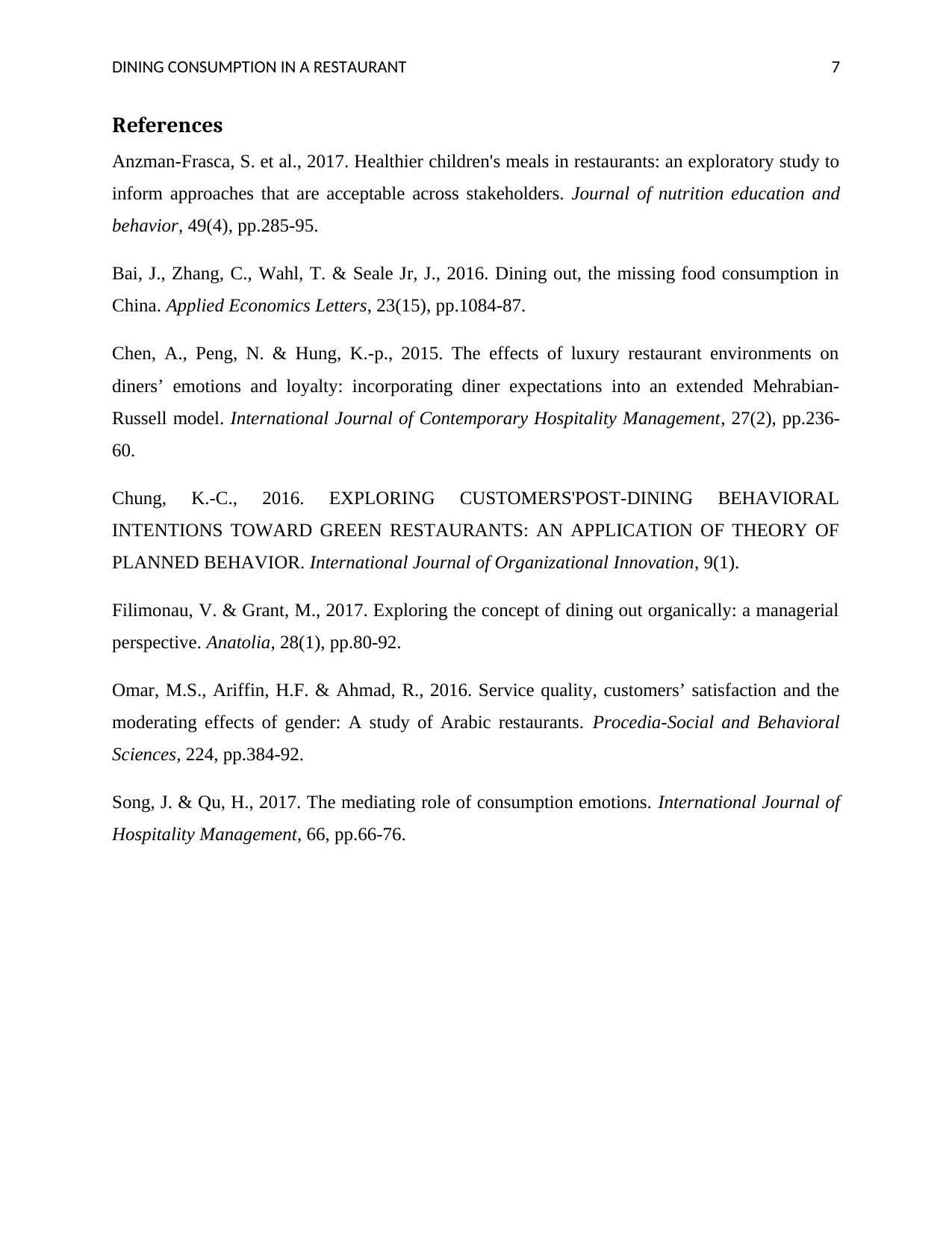
DINING CONSUMPTION IN A RESTAURANT 7
References
Anzman-Frasca, S. et al., 2017. Healthier children's meals in restaurants: an exploratory study to
inform approaches that are acceptable across stakeholders. Journal of nutrition education and
behavior, 49(4), pp.285-95.
Bai, J., Zhang, C., Wahl, T. & Seale Jr, J., 2016. Dining out, the missing food consumption in
China. Applied Economics Letters, 23(15), pp.1084-87.
Chen, A., Peng, N. & Hung, K.-p., 2015. The effects of luxury restaurant environments on
diners’ emotions and loyalty: incorporating diner expectations into an extended Mehrabian-
Russell model. International Journal of Contemporary Hospitality Management, 27(2), pp.236-
60.
Chung, K.-C., 2016. EXPLORING CUSTOMERS'POST-DINING BEHAVIORAL
INTENTIONS TOWARD GREEN RESTAURANTS: AN APPLICATION OF THEORY OF
PLANNED BEHAVIOR. International Journal of Organizational Innovation, 9(1).
Filimonau, V. & Grant, M., 2017. Exploring the concept of dining out organically: a managerial
perspective. Anatolia, 28(1), pp.80-92.
Omar, M.S., Ariffin, H.F. & Ahmad, R., 2016. Service quality, customers’ satisfaction and the
moderating effects of gender: A study of Arabic restaurants. Procedia-Social and Behavioral
Sciences, 224, pp.384-92.
Song, J. & Qu, H., 2017. The mediating role of consumption emotions. International Journal of
Hospitality Management, 66, pp.66-76.
References
Anzman-Frasca, S. et al., 2017. Healthier children's meals in restaurants: an exploratory study to
inform approaches that are acceptable across stakeholders. Journal of nutrition education and
behavior, 49(4), pp.285-95.
Bai, J., Zhang, C., Wahl, T. & Seale Jr, J., 2016. Dining out, the missing food consumption in
China. Applied Economics Letters, 23(15), pp.1084-87.
Chen, A., Peng, N. & Hung, K.-p., 2015. The effects of luxury restaurant environments on
diners’ emotions and loyalty: incorporating diner expectations into an extended Mehrabian-
Russell model. International Journal of Contemporary Hospitality Management, 27(2), pp.236-
60.
Chung, K.-C., 2016. EXPLORING CUSTOMERS'POST-DINING BEHAVIORAL
INTENTIONS TOWARD GREEN RESTAURANTS: AN APPLICATION OF THEORY OF
PLANNED BEHAVIOR. International Journal of Organizational Innovation, 9(1).
Filimonau, V. & Grant, M., 2017. Exploring the concept of dining out organically: a managerial
perspective. Anatolia, 28(1), pp.80-92.
Omar, M.S., Ariffin, H.F. & Ahmad, R., 2016. Service quality, customers’ satisfaction and the
moderating effects of gender: A study of Arabic restaurants. Procedia-Social and Behavioral
Sciences, 224, pp.384-92.
Song, J. & Qu, H., 2017. The mediating role of consumption emotions. International Journal of
Hospitality Management, 66, pp.66-76.

DINING CONSUMPTION IN A RESTAURANT 8
⊘ This is a preview!⊘
Do you want full access?
Subscribe today to unlock all pages.

Trusted by 1+ million students worldwide
1 out of 9
Related Documents
Your All-in-One AI-Powered Toolkit for Academic Success.
+13062052269
info@desklib.com
Available 24*7 on WhatsApp / Email
![[object Object]](/_next/static/media/star-bottom.7253800d.svg)
Unlock your academic potential
Copyright © 2020–2025 A2Z Services. All Rights Reserved. Developed and managed by ZUCOL.





